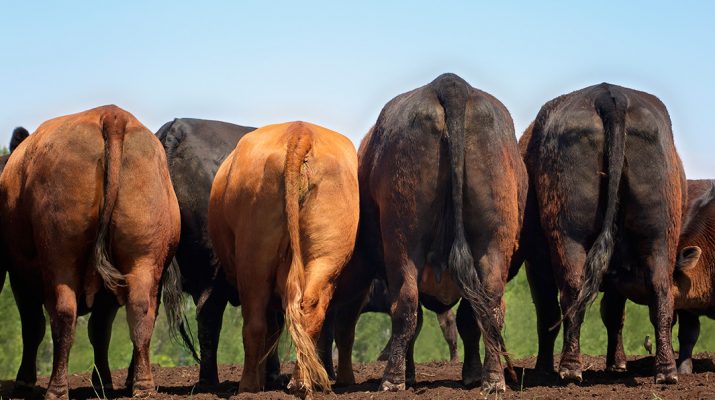Philip Hopkins
THE state government must take “significant action” to cut livestock emissions by preparing the state’s beef and dairy farmers to immediately put in place technologies to reduce methane emissions from cattle.
That is a key recommendation of the report, ‘Victoria’s 2035 Climate Action Target: Driving Growth and Prosperity’, which was written by an independent expert panel for the state government. “More than 80 per cent of feedlot and dairy cattle, and around a third of pasture-fed beef, will need to be treated with these technologies by 2035,” it says.
The report, released in March, was commissioned in January last year by the Minister for Energy, Environment and Climate Change, Lily D’Ambrosio, to aClimate Change Act. The government aims to reduce greenhouse gas emissions by 80 per cent by 2035 and net zero by 2045.
The report said agriculture accounted for 19 per cent of Victoria’s total emissions, with beef and dairy cattle making up almost half of this. “Addressing emissions from these animals is the most immediate large opportunity in this sector to reduce emissions,” the report said.
“Action for feedlot cattle can be complemented where possible with other actions, including for example on-farm energy efficiency or transition from diesel to electric technologies.”
Other key recommendations were:
-Help agriculture to rapidly adopt technology to reduce livestock emissions by introducing policies that take into account the value chain, including incentives for farmers and buyers of goods and services.
-Accelerate the use of methane-inhibiting technology for livestock by backing commercialisation of promising options that can be demonstrated on Victorian farms.
The report acknowledged agriculture’s economic importance, with gross value of production $17.9 billion in 2020-21. However, “emissions reduction solutions for agriculture are not as advanced as solutions for other parts of the economy”.
The panel noted the importance of the state’s SmartFarms in research, innovation and development, and also ways to cut emissions through changes in farming practices, such as increasing carbon sequestration in paddocks.
Most important were the technological solutions to cut methane emissions, such as commercially available methane-inhibiting feed supplements and a methane vaccine still being developed.
Industry groups backed the push – Meat and Livestock Australia had committed to net zero emissions by 2030, while Dairy Australia aimed for a cut in emissions intensity of 30 per cent by 2030, the panel said.
The report said more efficient use of fertilisers could help cut emissions from soils. Reducing nitrous oxide emissions “can decrease acidification of soils and improve water and air quality,” it said.
In the longer term, the report said domestic and global markets for agriculture were signalling the need for the sector to reduce greenhouse gas emissions.
The Victorian Farmers Federation has not commented on the expert panel’s report. However, the VFF said in its submission to the panel that emissions from agriculture had remained fairly constant.
“We want to assure the panel that a
relatively flat line on emissions should not be seen as the sector not acting,” said Gerald Leach, the VFF’s chair of the environment, planning and climate change committee.
“The VFF believes this reflects the relative difficulties to reduce emissions further without a level of transformative change; the failure to report on emissions intensity of the production system; and the challenge of improvements in sequestration through on-farm action being attributed elsewhere.”
From Page 1
Mr Leach said agriculture continued to invest in R & D on how to mitigate and adapt to climate change. “What agriculture is doing is not always well understood by decision makers,” he said
“Practices that have been developed to also have wider biodiversity and welfare outcomes are perceived as ‘industrial farming’.”
The VFF emphasised that the failure of AEMO (Australian Energy Market Operator) or the state government to understand the impacts of transmission on agricultural productivity had created a social licence issue for adaptation. “Agriculture already believes they have unfairly born the costs of meeting previous targets. Seeing transmission projects that does not seek to understand the cost of that infrastructure to landholders is not fair,” Mr Leach said.
“We believe that like the footprint of renewable energy generation, land use for transmission or other public use should be at commercial consent.”
The VFF’s key requests to the panel included:
– The panel should hold regular industry meetings to identify issues that need modification of statutes in order to be able to adopt new technology or practice for climate outcomes;
– Acknowledge the key role that the Rural Research & Development Corporation can play in helping to reduce emissions without impacts on food security;
– Ensure that the planning system enables a balanced decision-making process;
– The panel should urge government to undertake community education on what climate adapting and mitigation looks like in different production systems. This is to avoid challenges from poorly informed community expectations and poorly targeted regulatory requirements, and;
– The panel should recognise that there is no single path forward to reduce agricultural emissions and that active engagement with industry is vital to ensure that farmers can act.
“Setting a target is meaningless if it can’t be achieved. For our members it is frustrating where they are seen as not acting when they know what they need to do but they are not able to implement changes,” Mr Leach said.
The VFF urged a regulatory framework that facilitates climate change adaptation and mitigation, unlike two planning system controls. For example, planning required the use of thermally inefficient construction material for shedding so they look better in the landscape; and controls that did not allow a total environmental consideration in regard to using minimum or no till practices required to reduce emissions from soil.
Mr Leach said the VFF was seeking assurances that the Victorian government will see agriculture as a trusted partner.

